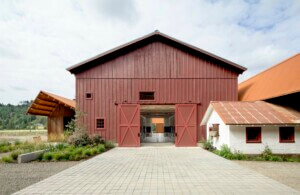This is the third article of AN‘s July/August 2019 print edition feature focused on development. The first, “A new breed of skyscraper threatens to devastate the fabric of New York,” can be read here. The second, “Why the developer’s vision matters in the experience economy,” can be read here.
As it celebrates the 250th anniversary of its founding this year, San Diego is rethinking past projects, planning billions of dollars’ worth of new projects, and coping with a housing shortage that is making it one of the nation’s least affordable markets.
The most significant project on the boards is the redevelopment planned for Horton Plaza shopping center, a 1985 postmodernist downtown mall designed by Jon Jerde. But there are many other megaprojects under construction or in the offing throughout this county of 3.3 million residents.
Laura Warner, an architect who moved from the San Francisco Bay Area in the 1980s, watches all this action from her perch as cochair of the San Diego Architectural Foundation’s Orchids & Onions program. This 43-year-old education effort celebrates the good and shames the bad in local building, landscape, planning, and historic preservation projects.
“We’ve got some really well crafted, well designed, and well detailed buildings that are places that people like to go to, where they want to create memories,” Warner said.
San Diego’s architectural zeitgeist goes back to its founding in 1769 by Spanish colonizers intent on protecting the area from European rivals and the local Kumeyaay population. The colonists introduced new building techniques, laid out towns as required by Spain’s “Laws of the Indies,” and built adobe and stucco ranch houses that remain the local go-to style, especially for residential development.
The city’s iconic buildings and structures include the Mission San Diego de Alcalá, Reid & Reid’s 1888 Hotel del Coronado, the 1915 Panama-California Exposition grounds in Balboa Park, the 1920s Navy and Marine Corps bases, the 1938 County Administration Center on the downtown waterfront, Louis Kahn’s 1964 Salk Institute, and William Pereira’s 1970 Geisel Library at the University of California, San Diego, campus.
Post–World War II car culture led to sprawl, center-city blight, and urban ills shared with other American cities. Some midcentury mistakes are being reversed, but challenges remain: homelessness, high-priced housing (the median home price in May was $591,000), large wage gaps between tourism service workers and high-tech engineers, and relations with Tijuana across the Mexican border.
Ten major projects in the works promise to add to San Diego’s collection of notable buildings, but it remains to be seen if any of them rise to world-class, must-see status in the decades ahead.
Stockdale Capital Partners of Los Angeles bought the Horton Plaza shopping center in 2018 for $175 million with plans to turn it into a high-tech office complex with only half the 600,000 square feet of retail originally required in the center. The Jerde Partnership’s original postmodern design was copied worldwide, and the new owners are seeking ways to retain some of its quirky features. L.A.-area firms RCH Studios and EYRC Architects are the design architects, and RDC is the executive architect for the redesign. The developers hope to complete the first phase by the end of 2020.
Chula Vista Bayfront
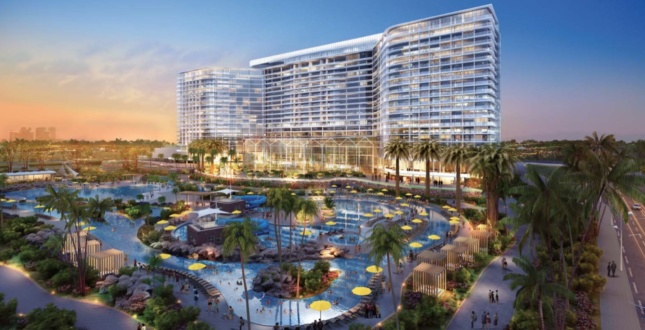
A 535-acre World War II-era industrial zone is being transformed into a complex comprising hotels, housing, retail, parks, and a conference center in this South Bay city’s portion of the San Diego port tidelands. Houston-based RIDA Development plans a $1.1 billion hotel and conference center on 36 acres. RIDA’s architect is HKS of Dallas.
Courthouse Redevelopment
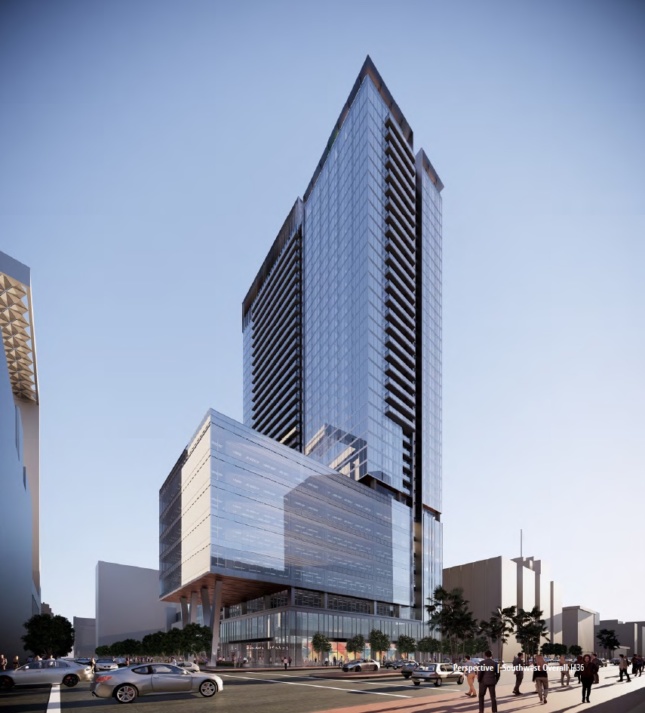
Another repurposing project involves the 1960s downtown county courthouse. On the first of three blocks owned by the county government would be a $400 million, 37-story mixed-use building developed by Vancouver, Washington–based Holland Partner Group and designed by local firm Carrier Johnson + Culture.
Manchester Pacific Gateway
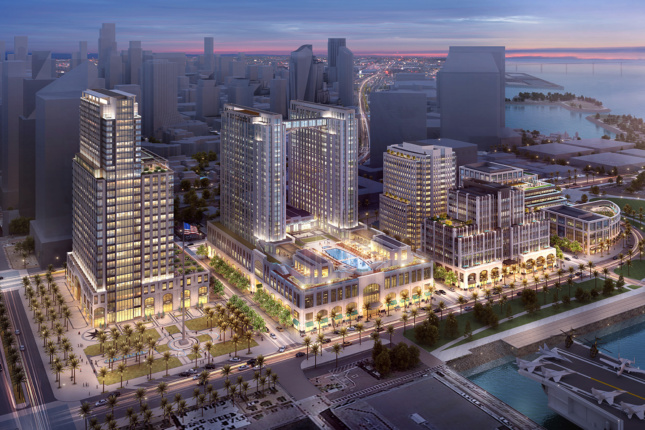
The Navy Broadway Complex, which dates back to the 1920s, has been leased to local developer Doug Manchester, who agreed to build the Navy a new West Coast headquarters. He, in turn, won rights to build hotels, offices, a retail galleria, and a museum on the balance of the complex’s 13.7 acres. Gensler is the architect, and construction of the tower is well underway in the $1.3 billion, 3 million-square-foot complex.
NAVWAR
The Naval Information Warfare Systems Command (NAVWAR, formerly the Space and Naval Warfare Systems Command or SPAWAR) occupies former Air Force hangars dating to World War II located between Old Town San Diego and the Marine Corps Recruit Depot north of downtown. The Navy, seeking a modern research and development home, would like to repeat its deal on the Naval Broadway Complex by signing up a developer who would deliver such a building in exchange for the right to develop the rest of the site privately. The 71-acre location is also being eyed by regional planners as a “Grand Central” multimodal transportation center. The Navy expects to issue a request for proposals.
In the meantime, the local National Association of Industrial and Office Parks chapter sponsored a “university challenge” for a portion of the site. The winning $1.6 billion, 4.1 million-square-foot “Delta District” plan from students at the University of San Diego includes offices, housing, and retail, plus an “innovation center” where education and R&D would meet. De Bartolo + Rimanic Design Studio of San Diego aided the UCSD students.
One Paseo
Suburban development continues in San Diego County, and one of the most controversial suburban projects, One Paseo, opened earlier this year east of Del Mar on the North County coast. Opponents, led by a rival shopping center company, objected to the density and launched an initiative to kill the project, and the developer, Kilroy Realty, downsized the plans. The retail portion, by the Hollywood architecture firm 5+design, opened earlier this year, and the first apartments are due this summer.
San Diego Convention Center Expansion
The center, built in 1989 and last expanded in 2001, will appear on the March 2020 city ballot in the form of a hotel tax increase that will fund an $800 million expansion, plus homeless and transportation improvements if it can gain the required two-thirds approval. The main new feature would be a rooftop public park. The project designer is Fentress Architects of Denver.
SDSU Mission Valley
San Diego State University won voter approval in 2018 over local developers’ rival “SoccerCity” to redevelop the 166-acre site of the former Chargers NFL football stadium site in Mission Valley, north of downtown. When the Chargers returned to Los Angeles, the future of the 70,000-seat, 52-year-old stadium was up for grabs. SDSU plans to replace what is now called SDCCU Stadium with a smaller facility for its Aztecs football team. Developers would be selected to build 4,600 housing units and 1 million square feet of office and retail space that ultimately could be repurposed for academic use to complement the university’s 250-acre campus a few miles to the east. Carrier Johnson + Culture prepared a conceptual master plan, and Gensler is the architect for the new $250 million stadium, which is targeted to open for the 2022 football season.
Seaport Village
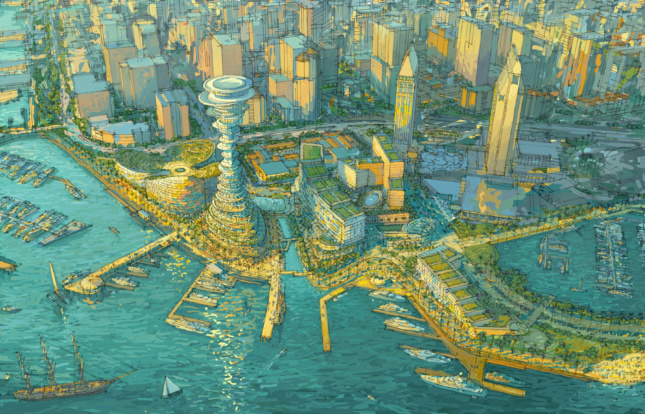
The downtown Embarcadero postindustrial transformation began with the construction of the Robert Mosher–designed San Diego–Coronado Bridge in 1969. The obsolete ferry landing was redeveloped as the Seaport Village specialty retail center in 1980. Now it’s time to turn the 39-acres of one-story buildings into something denser and more sophisticated. The current $1.6 billion plan calls for the usual mix of hotel and commercial uses plus an aquarium, ocean-oriented learning center, a 500-foot skytower ride designed by BIG, and water-centric recreational and commercial fishing features. The project architect is San Diego–based AVRP Skyport.
UC San Diego
The UC San Diego campus, whose first class of fewer than 200 students took up residence in 1964, is nearing an enrollment of 40,000 and is planning to add three more undergraduate residential colleges to the six already in place. The 2,100-acre campus, spanning Interstate 5 in San Diego’s La Jolla neighborhood plus a community hospital near downtown, has about $10 billion dollars in projects planned over the next 10 years. That doesn’t count the $2.1 billion extension of the San Diego Trolley light-rail system which is due to reach the campus in 2021. The campus trolley stop will lead to a new campus gateway entrance, where several major buildings and an outdoor amphitheater are in the works. An off-campus downtown hub on the trolley line is already under construction. Numerous architectural firms, both local and national, have been engaged to build out the campus, including HKS and San Diego–based Safdie Rabines Architects for Sixth College, now under construction; Seattle-based LMN Partners for the Triton Pavilion, a six-building complex at the new trolley stop; and the downtown hub by Carrier Johnson + Culture.
Roger Showley is a freelance writer who recently retired from The San Diego Union-Tribune.










